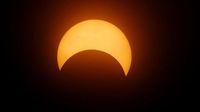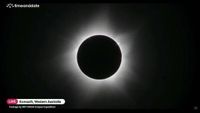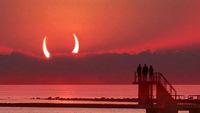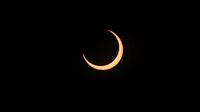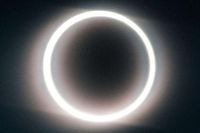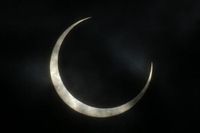A rare partial solar eclipse will grace the skies of France on Saturday, March 29, 2025. Astronomy enthusiasts and curious observers alike will have the opportunity to witness this celestial phenomenon, with varying degrees of visibility across different regions.
The Institut de mécanique céleste et de calcul des éphémérides (IMCCE) predicts that the eclipse will commence in France at 10:57 AM and conclude by 12:56 PM. The peak visibility is expected around 11:00 AM, providing a brief but striking moment for those fortunate enough to find clear skies.
In the northwestern city of Brest, enthusiasts can expect 32.5% of the sun’s surface to be obscured by the moon. Other major cities will experience lesser degrees of coverage: Paris will see 23.5%, while Lyon will witness just 15.7% of the sun hidden during the eclipse. Interestingly, in Nice, an exceptionally low 9.9% of the sun will be covered.
Observers in the USA will have a more impressive view, particularly in Washington, where more than 74% of the sun will be hidden. The revised data emphasizes that this partial solar eclipse will also be visible in parts of North America, Europe, and North Africa, commencing in Canada and ending in Siberia.
Comprising a natural spectacle, the solar eclipse serves as a reminder of the intricate dances between celestial bodies. A fascinating optical illusion known as 'Devil’s Horns,' characterized by red 'horns' shining in the sky, may occur if the eclipse coincides with either sunrise or sunset. This occurs due to the way light passes through the Earth's atmosphere at these times, lending the sun a reddish hue.
Of utmost importance, however, is the safety of those wishing to observe the eclipse. Experts continually stress the dangers of viewing the sun directly—even during an eclipse—without suitable protective gear. Basic sunglasses or homemade filters will not suffice. It is essential to don glasses that meet the stringent safety standards, specifically those certified under European regulations to avoid permanent eye damage.
If you lack appropriate eyewear, there are alternative methods for observing the eclipse indirectly. For instance, a simple pinhole projector made from cardboard can safely project the image of the sun. By directing sunlight through a small hole onto a flat surface, you can experience the beauty of this astronomical event without risking your vision.
The phenomenon of the partial solar eclipse, when the Earth, moon, and sun are not perfectly aligned, presents a remarkable opportunity for science as well as a natural spectacle. This eclipse serves as a reminder of the ever-changing dynamics of our solar system, revealing truths about solar phenomena.
Counting down to the event, curiosity spikes with remarks from experts reminding the public that for a truly immersive experience, clouds permitting, enthusiasts should prepare adequately. Local astronomy clubs and observatories may host viewing events, allowing citizens to gather for this shared experience under expert supervision.
Looking ahead, the next partial solar eclipse visible in France will occur on August 12, 2026, while a total solar eclipse—a sight rarer than a partial event—will not grace France until September 3, 2081. The period leading up to these astronomical events will bring excitement to skywatchers, each hoping to catch a glimpse of the majestic interplay between cosmic entities.
In the meantime, as the date of the partial eclipse approaches, individuals are encouraged to contemplate the history of such celestial events, which have often inspired awe and wonder within humanity. Whether a seasoned astronomer or a curious newcomer, the eclipse of March 29, 2025, promises a moment worth experiencing, as celestial bodies align once more in a dazzling display.
